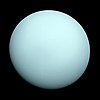Uranus is the seventh planet from the Sun; it is the third largest and fourth most massive planet in the Solar System. Uranus was the first planet discovered in modern times. Though it is visible to the naked eye like the five classical planets, it was never recognised as a planet by ancient observers due to its dimness. Sir William Herschel announced its discovery on March 13, 1781, expanding the known boundaries of the solar system. Uranus' atmosphere, although similar to Jupiter and Saturn in being composed primarily of hydrogen and helium, contains a higher proportion of "ices" such as water, ammonia and methane, along with the usual traces of hydrocarbons. It has the coldest planetary atmosphere in the solar system, with a minimum temperature of 49 K, and has a complex layered cloud structure in which water is thought to make up the lowest clouds, while methane makes up the uppermost layer of clouds. In 1986, images from the Voyager 2 space probe showed Uranus as a virtually featureless planet in visible light without the cloud bands or storms associated with the other giants. The wind speeds on Uranus can reach 250 m/s (560 mph).
